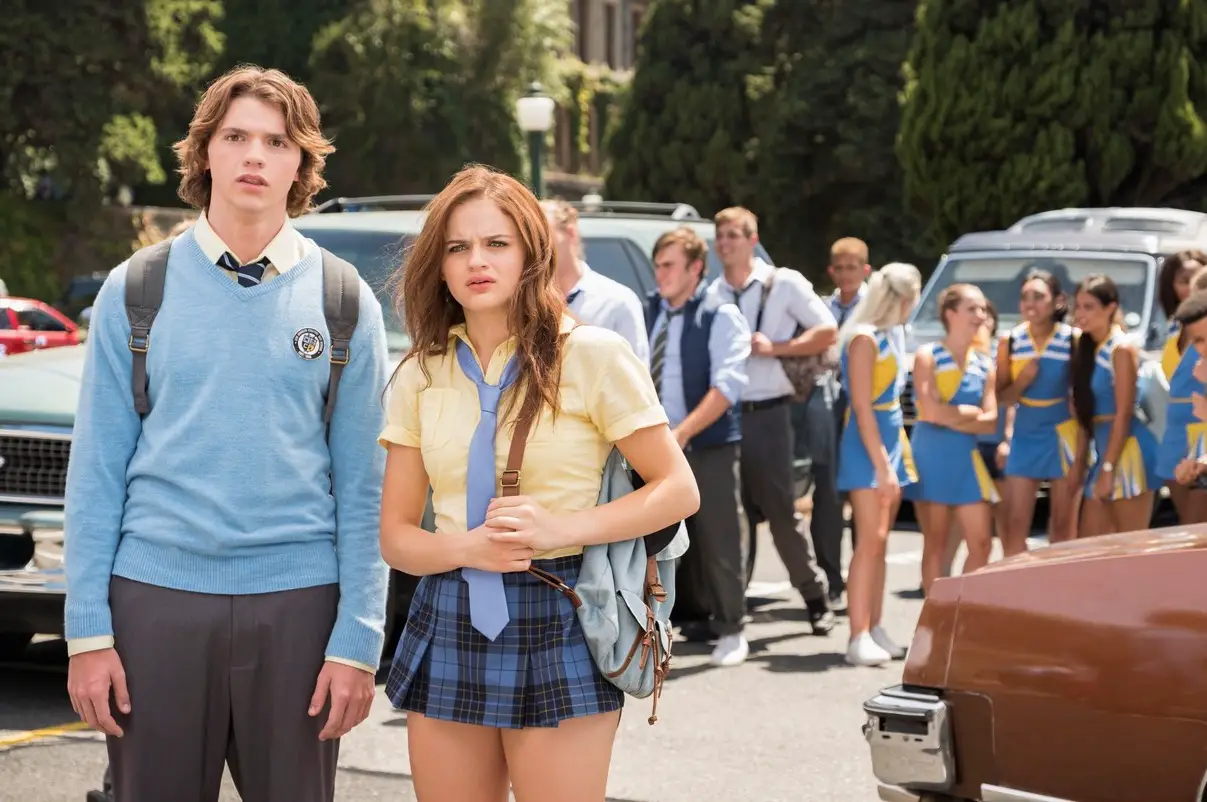The romance genre is currently booming in popularity and drawing more public admiration than ever before. In 2021, Publishers Weekly recorded that the sixth highest selling novel was the romance writer Colleen Hoover’s book “It Ends with Us” with 768,693 copies purchased. Some other books from the same genre that made the list include 12th place’s Madeline Miller’s “The Song of Achilles” with 652,906 copies sold and Taylor Jenkins Reid’s “The Seven Husbands of Evelyn Hugo,” which placed 19th with 562,002 copies sold. Furthermore, on the social media app TikTok, a large community dubbed BookTok promotes and reads new and older romance novels. The entertainment industry has also not shied away from the genre, especially Netflix, a streaming service known for its teen rom-coms.
A recent example of one of their romance projects is “Tall Girl 2,” a sequel to the 2019 film “Tall Girl.” The increased consumption of stories about love is understandable and even necessary due to the current state of the world. However, the never-ending production of seemingly similar romance TV shows and movies geared toward teenagers from companies like Netflix garner questions about the artistry, intent and messages found within these projects.
Netflix’s History
When Reed Hastings and Marc Randolph founded Netflix in 1997, the company’s initial objective was to focus on DVD rentals. In September 1999, the business added a monthly subscription service; the per-rental model ceased in early 2000 and Netflix changed its business model so that customers would pay a flat fee each month for unlimited rentals. The shift also eliminated certain built-in fees like late fees and shipping and handling charges. In January 2007, the organization launched an online streaming site with close to 1,000 available movies along with its preexisting DVD rental service. In 2010, Netflix transitioned to streaming only and expanded outside of America to other nations around the globe. From there, Netflix, to this day, dominates the streaming service market on a global scale.
Another important moment in Netflix’s history is the decision to create and distribute its own original programming, Netflix Originals. On Feb. 1, 2013, Netflix debuted its first-ever original television show, “House of Cards.” Based on and adapted from the BBC series and novel of the same name by Michael Dobbs, the production starred Kevin Spacey — a man now infamous for multiple sexual misconduct allegations — and was met with praise from critics and viewers. In the same year, the streaming service came out with another commercially and critically successful TV show, “Orange Is the New Black,” based on the memoir “Orange Is the New Black: My Year in a Women’s Prison” by Piper Kerman. Netflix went from a rental service to a company with respectable original content, which also attracted new consumers to the platform.
A Change in Content
When Netflix first introduced the programming unique to the streaming service, it appeared as if the company would specialize in or at least be known for its dramas. While the idea had been true for a couple of years, everything changed with the release of its first teen rom-com, “The Kissing Booth.” Based on the novel first independently published on Wattpad by Beth Reekles, the movie follows Shelley “Elle” Evans (played by Joey King), a teenage girl with a crush on her best friend’s older brother, Noah Flynn (played by Jacob Elordi). Both characters end up in a secret romance after a kiss they shared at a kissing booth Elle is running during their school’s spring carnival.
While critics universally panned the film, that did not stop the movie from being a massive success. According to Netflix and The Hollywood Reporter, “One in three viewers of ‘The Kissing Booth’ … have re-watched the high school set rom-com, which is 30 percent higher than the average movie re-watch rate” on the platform. Before the film came out, Netflix had produced only one romantic comedy the year prior targeted at adult women, a film titled “A Christmas Prince.” After the surprising breakthrough of “The Kissing Booth,” however, Netflix greenlit two sequels and more teen rom-coms and romance movies in general. The company officially moved away from dramatic works appealing to adults and award shows, to another, previously untapped market: teenagers who enjoy fun love stories with a formulaic structure.
Problematic Trends in these Films
(Before expanding on this topic, it is important to note that there will be spoilers for the movies mentioned after this warning. If you do not want to know specific details about these projects, move on to the next section).
Netflix’s teen rom-coms are entertaining, typically two-hour experiences where adolescents (and some adults) can live out their romantic fantasies with an extremely attractive cast of characters. People can just turn off their brains. Not all media needs to be serious or intellectually stimulating.
While this is true, studios should still put energy and passion into these projects instead of just following a template. In Netflix teen rom-coms, there are multiple story beats in the movies that match other movies in the genre, such as sequels that add a conflict — often coming in the form of another love interest — to the couple that formed in the original. Other similarities include convoluted plots, as well as the inclusion of inspirational messages or elements aimed specifically at modern teens, like the incorporation of social media in the storyline (i.e., “The Perfect Date”).
Also, these films possess problematic commonalities that perpetuate certain stereotypes, tropes or ideas. For one, the framing of the main character and love interest excuses their poor behaviors and attitudes. In “The Kissing Booth,” Noah, in more than one instance, displays extreme aggression toward other people, such as when he slams his hand on a car hood to get Elle to stop running away from him. Additionally, he is shown to be controlling, patronizing and a toxic person to be in a relationship with. Without the romantic lens, Noah would normally be seen as an emotionally abusive boyfriend.
On the flip side, productions try to paint the protagonists as victims or people who have hard lives to gain sympathy from the audience. In “Sierra Burgess Is a Loser,” main character Sierra Burgess is supposed to be someone to root for because her classmates make fun of her weight and physical appearance. Bullying is never acceptable, but throughout the rest of the film, Sierra’s actions are considerably worse in comparison to the bullies. She catfishes her love interest, Jamey, and kisses him without his consent, pretends to be deaf to keep up her ruse and publicly shares private photos of another person to humiliate them. None of these acts are shown in a way that acknowledges Sierra is in the wrong.
In “Tall Girl,” the main character, Jodi Kreyman, believes that her life is horrible because she is 6’1” and is constantly teased about it. Again, bullying another person is not right. The apparent issue with this notion is that Jodi’s biggest problem is her height. She is a well-off, cis and straight white girl from a nice neighborhood. Being taller than average as a woman can feel daunting, but her height is not a disability or an uncontrollable aspect of her identity that is systemically oppressed in society. Her tone-deaf beliefs are not called out or addressed at any point. She gains confidence at the end but not a realistic perspective on the world.
Another recurring matter is the inclusion of performative diversity. “Tall Girl” and “Sierra Burgess Is a Loser” possess the token Black friend trope, in which the Black characters do not have a storyline outside of the white protagonist. In relation to the romances, in the sequels to “The Kissing Booth” and “To All the Boys I’ve Loved Before,” two new love interests, Marco Peña and John Ambrose respectively, are introduced as threats to the couple. Both men, who are people of color, act as short detours for the female lead before she realizes that she belongs with the white male lead. Marco and John are nice, caring teenage boys who treat the main characters with more respect than their actual boyfriends. These two are fitting matches for Elle and Lara Jean, but the movies disregard them.
Moreover, the majority of these movies center a heterosexual couple who has a heteronormative relationship. “The Kissing Booth 2” and “He’s All That” have queer characters who become romantically involved, but those storylines are in the background and have no major influence on the plot. There are no openly transgender, nonbinary or gender-nonconforming leads or love interests. Netflix continues to produce stories that represent a small, set type of person or community in the romance genre.
(Hopefully) The Future of Netflix Teen Rom Coms
To be clear, being a fan of movies like these is not something to feel bad or guilty about. Romance and teen rom-coms have been looked down upon for decades, which is not fair and also inherently sexist, as the genre’s main demographic is women. However, media, even more lightweight pieces, deserve to be, and should be, analyzed or criticized when necessary. Netflix’s production of so many teen rom-coms is not a grand disservice to the world, but the company should strive to craft more thought-out and inclusive works. Hopefully, the streaming service will listen to these comments as well as many others and produce better but still amusing projects from here on out.
















